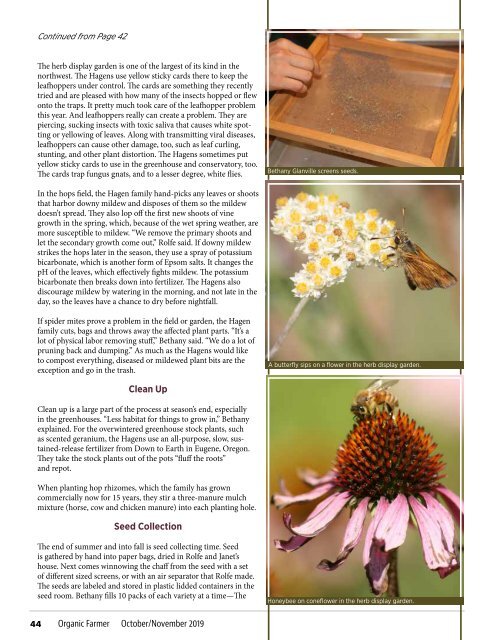Organic Farmer October/November 2019
Create successful ePaper yourself
Turn your PDF publications into a flip-book with our unique Google optimized e-Paper software.
Continued from Page 42<br />
The herb display garden is one of the largest of its kind in the<br />
northwest. The Hagens use yellow sticky cards there to keep the<br />
leafhoppers under control. The cards are something they recently<br />
tried and are pleased with how many of the insects hopped or flew<br />
onto the traps. It pretty much took care of the leafhopper problem<br />
this year. And leafhoppers really can create a problem. They are<br />
piercing, sucking insects with toxic saliva that causes white spotting<br />
or yellowing of leaves. Along with transmitting viral diseases,<br />
leafhoppers can cause other damage, too, such as leaf curling,<br />
stunting, and other plant distortion. The Hagens sometimes put<br />
yellow sticky cards to use in the greenhouse and conservatory, too.<br />
The cards trap fungus gnats, and to a lesser degree, white flies.<br />
Bethany Glanville screens seeds.<br />
In the hops field, the Hagen family hand-picks any leaves or shoots<br />
that harbor downy mildew and disposes of them so the mildew<br />
doesn’t spread. They also lop off the first new shoots of vine<br />
growth in the spring, which, because of the wet spring weather, are<br />
more susceptible to mildew. “We remove the primary shoots and<br />
let the secondary growth come out,” Rolfe said. If downy mildew<br />
strikes the hops later in the season, they use a spray of potassium<br />
bicarbonate, which is another form of Epsom salts. It changes the<br />
pH of the leaves, which effectively fights mildew. The potassium<br />
bicarbonate then breaks down into fertilizer. The Hagens also<br />
discourage mildew by watering in the morning, and not late in the<br />
day, so the leaves have a chance to dry before nightfall.<br />
If spider mites prove a problem in the field or garden, the Hagen<br />
family cuts, bags and throws away the affected plant parts. “It’s a<br />
lot of physical labor removing stuff,” Bethany said. “We do a lot of<br />
pruning back and dumping.” As much as the Hagens would like<br />
to compost everything, diseased or mildewed plant bits are the<br />
exception and go in the trash.<br />
A butterfly sips on a flower in the herb display garden.<br />
Clean Up<br />
Clean up is a large part of the process at season’s end, especially<br />
in the greenhouses. “Less habitat for things to grow in,” Bethany<br />
explained. For the overwintered greenhouse stock plants, such<br />
as scented geranium, the Hagens use an all-purpose, slow, sustained-release<br />
fertilizer from Down to Earth in Eugene, Oregon.<br />
They take the stock plants out of the pots “fluff the roots”<br />
and repot.<br />
When planting hop rhizomes, which the family has grown<br />
commercially now for 15 years, they stir a three-manure mulch<br />
mixture (horse, cow and chicken manure) into each planting hole.<br />
Seed Collection<br />
The end of summer and into fall is seed collecting time. Seed<br />
is gathered by hand into paper bags, dried in Rolfe and Janet’s<br />
house. Next comes winnowing the chaff from the seed with a set<br />
of different sized screens, or with an air separator that Rolfe made.<br />
The seeds are labeled and stored in plastic lidded containers in the<br />
seed room. Bethany fills 10 packs of each variety at a time—The<br />
Honeybee on coneflower in the herb display garden.<br />
44<br />
<strong>Organic</strong> <strong>Farmer</strong> <strong>October</strong>/<strong>November</strong> <strong>2019</strong>


















